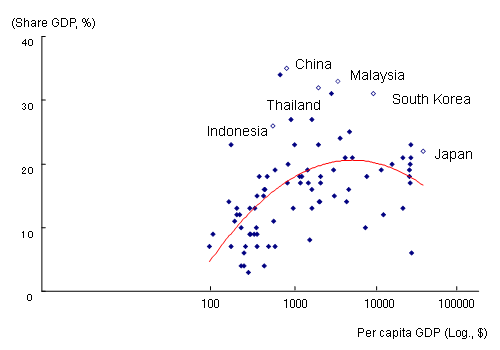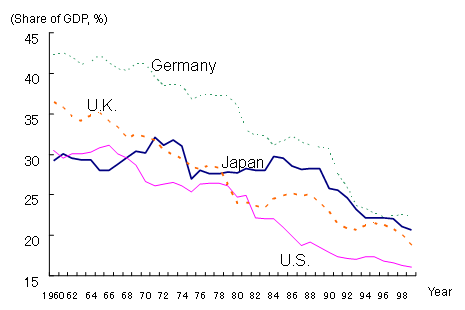With industrialization gathering pace, China has been drawing a great deal of attention as the workshop of the world. As proof, it is often cited that the manufacturing sector accounts for a hefty 35% of China's gross domestic product (GDP). Many Japanese believe that the industrial structure of China has evolved to the point of an advanced country, while in fact it is typical of newly industrializing one. This is conspicuous especially in the light of the growing tendency in high-income countries to shift into service-oriented industrial structures.
It is generally known that industrial structure evolves from primary industry to secondary, then to tertiary, reflecting the shift in demand from food to industrial products, then to services in accordance with an increase in people's income (Petty-Clark's Law). It has been observed in many countries that the manufacturing sector's share within a country's overall economy goes up at an early stage of economic development but declines when the country's economic level approaches that of advanced countries. The transfer of labor force and other production factors from the industrial sector to the service sector, as well the decline in the relative prices of industrial products vis-a-vis services, contribute to such changes.
At this point, let us try to confirm the relationship between economic development and industrial structure through both cross-section and time-series approaches.
By plotting data on 83 countries from the World Bank's World Development Indicators, one can see that there is a parabolic relationship between the proportion a country's manufacturing sector contributes to its GDP and that country's overall per capita GDP, a measure of economic development. This demonstrates that the manufacturing sector's share in the overall economy begins to decline as per capita GDP reaches around $4,500. The manufacturing sector's share of GDP in China is higher than that of other countries at a similar income level. This phenomena, however, is common to Asian countries and a distinctive characteristic of the "Asian miracle." In the early 1970s when Japan was in the final stage of its high growth period, the manufacturing sector's share of GDP also reached a level comparable to today's China.
Time-series data for major countries ( table 2 ) also shows that the manufacturing sector's share of GDP in advanced countries, including Japan and the United States, has fallen to about 20 percent in recent years. The ratios are on the rise in the member states of the Association of Southeast Asian Nations (ASEAN) whose income levels still remain low, but have begun to fall in newly industrializing economies (NIEs) in Asia whose income levels have risen to those of advanced countries, such as members of the Organization for Economic Cooperation and Development.
Thus, de-industrialization is a phenomenon that is common to advanced countries. The perception that an industrial country is an industrialized country no longer reflects the reality of the world economy. In the five decades following the end of the war, Japan developed into a major economic power by concentrating resources on the manufacturing sector. Given this successful experience, it is quite understandable that many Japanese are passionate about manufacturing. This attitude, however, seems to be an obstacle to bringing Japan's industrial structure into a higher stage of development. Japan should be concerned that it is lagging behind other advanced countries in a shift into a service-oriented industrial structure rather than worrying about having its industrial bases eroded by China. To maintain its status as an advanced country, Japan should promote de-industrialization.
Table 1 : A cross section comparison of manufacturing sector's share of GDP (2000)

(Source)Compiled by the author based on World Development Indicators 2002, World Bank.
Table 2 : Changes in Manufacturing Sectors' Share of GDP in Major Industrial Countries (1960-1999)

(Source)Compiled by the author based on Comparative Economic and Financial Statistics, Bank of Japan and National Accounts of OECD Countries, OECD.


